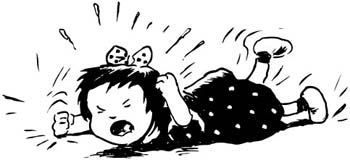 A child is screaming, crying, and raging, making their emotional distress visible, audible, and sometimes even tangible for anyone within reach. We’ve all been there — either as a child, as a parent, or as an uncomfortable bystander.
A child is screaming, crying, and raging, making their emotional distress visible, audible, and sometimes even tangible for anyone within reach. We’ve all been there — either as a child, as a parent, or as an uncomfortable bystander.
The common terms for such an occurrence are “tantrum” or “meltdown.” It’s an event that most, if not all, parents would like to avoid, yet we often unwittingly make our children’s “meltdowns” last longer or burn hotter than necessary, in part because we have outdated ideas about “tantrums.”
Why do children have “tantrums”?
Many parents today still think that children have “tantrums” because they’re not getting their way. We’ve inherited the “spoiled brat” theory popular during our own childhoods. What the research widely points to, however, is that these big emotional releases are the result of immature brains under stress — particularly feelings of anger, frustration, or anxiety. By “immature” I mean brains in which the prefrontal cortex — our most sophisticated “human” brain — has yet to fully develop (this maturation typically starts around age 4). Though we adults don’t like dealing with “meltdowns,” one of the best things we can do is adopt a more neutral view of them. In other words, instead of viewing them as a your child’s “bad behavior,” view them as your child’s best effort to respond to stress she’s feeling.
How do we get through “tantrums” without everything going to pieces?
Changing our reactions to “tantrums” from our children is an ongoing process. When most of us were children, these were some of the beliefs that were common about “tantrums:”
- “Tantrums” are the result of:
- Pushover parents who refuse to set limits on their children, or
- Spoiled, demanding, selfish, out-of-control children.
- A child having a tantrum should be controlled.
- Tantrums that aren’t stopped lead to a child having even more tantrums.
- Tantrums have only negative value (i.e., there is nothing positive about a tantrum).
Thus, most of us took on these beliefs about “tantrums” and so we tend to react in much the same way as our parents did. Usually this means either feeling angry and wanting to stop our child’s meltdown or feeling overwhelmed and wanting to disappear until the storm has passed.
But since these reactions aren’t productive (or usually pleasant), it’s up to us to learn new ways to ride out the storm (because it will eventually pass). If you’re ready to ditch the old ways of handling toddler “tantrums” for more effective and compassionate responses, I invite you to click here for your free copy of my New Take on Tantrums tip sheet . In my video below, I share three simple changes you can make to reduce the severity and duration of child “meltdowns.”